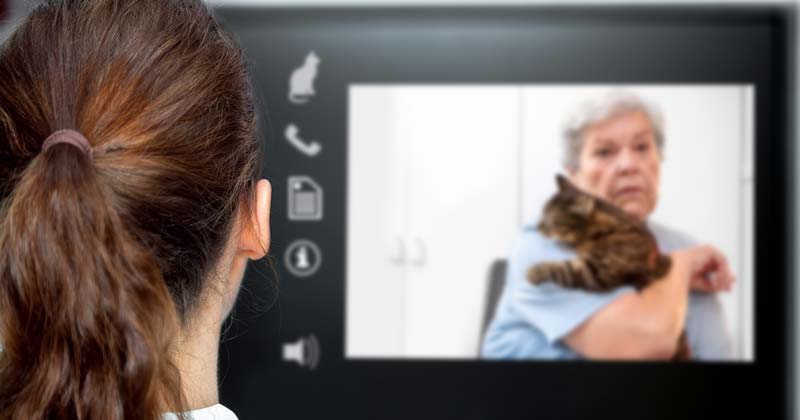20 Jul 2020
The catch-22 of flexible working
In the final of a three-part series looking at how COVID-19 has impacted on women working in the profession, Veterinary Woman editor Liz Barton talks about how the shift towards working from home and flexible working has highlighted both challenges and opportunities moving forwards…

Image © Cultivate / Adobe Stock

Working part-time as a vet and coming home to a demanding family life is no walk in the park.
It is by no means the “weaker sex” electing to spend more time at home with the “easier” role of household and caring responsibilities. Indeed, many of the motivators and drivers for satisfaction are easier to find in the workplace than in the often mundane, thankless and relentless demands at home.
Flexible working is thrust on us as a needs-must solution to ensure life actually happens, over and above any sense of work-life balance. It’s important we start to talk more about the challenges this presents for individuals and businesses – and take the learnings from the COVID lockdown to shape more sustainable working life in the future.
Flexible working for vets is no panacea
The benefits of flexible working have been much championed and discussed, with potential gains for both veterinary employer and employee1,2.
I recently took part in the Global Veterinary Career Summit panel discussion titled “What have we learned about flexible working through COVID?” To my own mild dismay, I found myself quoting papers and statistics about the negative impacts working flexibly has had – on women in particular.
There is too much to say about how gender inequalities have been exacerbated since lockdown began. Now, as someone who is usually a staunch advocate of facilitating flexibility in workplaces and careers, it somewhat jarred to be talking about the drawbacks.
Some very important messages exist that we need to pay attention to, to mitigate the effects of the pandemic driving the wedge of gender divide even deeper.
Mitigating negatives of flexibility in veterinary practice
I’ve already hinted at some of the drawbacks of flexible working and home-based work. It’s harder to foster that all-important feeling of belonging as a primary motivator.
Creating boundaries is difficult if work is only a laptop lid flip away; the distractions are endless. Indeed, a study by the Institute of Fiscal Studies and University College London highlighted the fact that parents are now often doing at least two activities at the same time3. It’s multitasking on steroids.
The shift to remote client consultations and virtual work meetings can compound feelings of loneliness and isolation. It’s vital to maintain regular contact, and engage team members in practice news and discussions remotely.
As a SPVS board member, I have written guides on what you can do as an employer and as a practice to support the well-being of staff, plus tips for individuals on how to stay healthy in mind and body4.
Apparently, only 7% of practices are intending to continue with some form of teleconsultation once normal service is resumed. I would counsel that 93% to canvass opinion from both staff and clients.
Properly charged remote services can provide opportunities for staff to work in a more flexible home-based role. In addition, it offers clients the potential to have a “consultation” with their regular practice when on holiday, or if they move away and value continuity with their former practice. It’s also easier for those with time and transport constraints, or difficult or aggressive pets.
Facilitating healthy remote working
We have to train ourselves to work smart and healthily within the new normal. For many, this may involve clear and robust boundary setting. This goes hand in hand with presenteeism – where our mind is somewhere other than the task in hand.
Learning how to create clear temporal and mental divisions between the different demands on our finite capacity is key to maintaining efficiency and control. This can be a learned skill and something we should be making as easy as possible to develop.
Teaching the art of remote consultation and client communication with reduced body language cues is also key to making the adoption of this method work well for all parties. Until the schools and childcare provision returns to some sense of normality, remote consulting will help retain parental talent within the workforce.
Importantly, staff must be actively engaged in practice communications and discussion, whether they are furloughed or having to self-isolate. Simply checking in and making sure people are okay is vital when we’re seeing a downturn in mental health across much of society.

What is the hope for women during this crisis?
Numerous positive socio-economic outcomes have the potential to emerge post-pandemic:
- increased opportunity for flexible working for all career stages
- increased familiarity with – and acceptance of – virtual consultation, meeting and communication methods
- increased opportunity to work from home
- increased social acceptance of flexible working/working from home
- reducing the north-south employment divide
Working from home is likely to become more socially acceptable, which could foster more gender parity in role sharing in the long term. Employers are also habituated to flexing rotas and offering flexible alternatives as we move through the phases of gradual reopening.
Geographical limits are not presenting the same barrier as they were before lockdown. We’re getting used to remote working and virtual meetings.
Businesses are reassured that staff are able to work from home professionally and productively. This realisation opens up the potential to unleash talent from individuals nationwide.
Already, I’ve heard of London-based organisations taking on new staff from the north, whereas previously they’d restricted themselves to the commuter belt – including veterinary practice staff in office roles. This could help to even the north-south divide.
Why not apply the same logic for women in work?
Just because women are restricted within childcare set hours, now we should be actively looking to facilitate not just a status quo part-time role, but career development and progression – whether that’s remote teaching roles, teleconsultation or practice managerial roles.
And can we please, please look at increasing accessibility of residencies and specialist training to those who are unable to put life on hold for three or more years? It’s simply outdated as a method of training – utterly out of sync with the demands of modern life.
Championing veterinary women
It’s a consistent finding in studies that women need more support, encouragement and confidence building than men to progress in careers. It’s also true that women face more challenges, both in terms of bias, and increased expectation and demands on time and resources.
We know with all forms of discrimination that simply not being a part of the problem is ineffective in actioning change. We have to actively participate in calling out gender discrimination, and in providing support and facilitating the continued careers of women – in the veterinary sphere and beyond. If you would like to learn more, or have anything you’d like to contribute, Veterinary Woman would love to hear from you.
Be part of the solution
Awareness is the first step to addressing problems, so thank you for reading. Those interested in a more in-depth discussion of the issues in this article can read more at Veterinary Woman.
We want to hear your experiences and ideas on how we can better facilitate women in the workplace through and beyond COVID-19. To be representative we need diverse representation and would like to invite women from across the industry to take part.
Follow our Facebook page for upcoming polls to feed into this work, and to share your story or contribute, email info@veterinarywoman.co.uk
